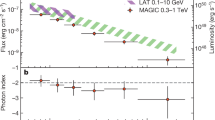Abstract
THE possibility of monochromatic radio emission from galactic deuterium has been well known for some time, and the frequency of such an emission line predicted by Shklovsky1. The expected maximum intensity is such that any attempt to detect the line must rely on extremely long integrations in time. In practice, this requires either direct electrical integrations over a long period or the manual summation of a series of individual records. One attempt to detect the line using manual methods has already been published2.
This is a preview of subscription content, access via your institution
Access options
Subscribe to this journal
Receive 51 print issues and online access
$199.00 per year
only $3.90 per issue
Buy this article
- Purchase on Springer Link
- Instant access to full article PDF
Prices may be subject to local taxes which are calculated during checkout
Similar content being viewed by others
References
Shklovsky, I. S., Astrophys. J. U.S.S.R., 29, 144 (1952).
Getmanzev, G. G., Stankevitch, K. S., and Troitsky, V. S., Jodrell Bank Symposium on Radio Astronomy, 1955.
van de Hulst, H. C., Muller, C. A., and Oort, J. H., Bull. Astro. Neth., 12, 452 (1954).
McGee, R. X., Slee, O. B., and Stanley, G. J., Aust. J. Phys., 8, 347 (1955).
Author information
Authors and Affiliations
Rights and permissions
About this article
Cite this article
STANLEY, G., PRICE, R. An Investigation of Monochromatic Radio Emission of Deuterium from the Galaxy. Nature 177, 1221–1222 (1956). https://doi.org/10.1038/1771221a0
Issue Date:
DOI: https://doi.org/10.1038/1771221a0
This article is cited by
-
A New Upper Limit to the Galactic Deuterium-to-Hydrogen Ratio
Nature (1962)
-
Intensity of the Radio Line of Galactic Deuterium
Nature (1957)
Comments
By submitting a comment you agree to abide by our Terms and Community Guidelines. If you find something abusive or that does not comply with our terms or guidelines please flag it as inappropriate.



